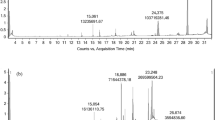Abstract
Supercritical CO2 extracts of the marine diatom Chaetoceros muelleri (gracilis) have been investigated for their potential use as food preservatives, namely, as antimicrobials. A screening of different pressures and temperatures for supercritical CO2 extraction was assayed in order to determine the main factors controlling the yield and antimicrobial activity of the extracts. Since the potential antimicrobial activity of these CO2 extracts is mainly induced by the lipidic fraction, HPLC with evaporative light scattering detection (HPLC-ELSD) and GC with flame ionization detection (GC-FID) were used to identify lipid families and fatty acids, respectively. Antimicrobial activity of the extracts was measured against Staphyloccocus aureus, Escherichia coli and Candida albicans. Possible correlations between antimicrobial activity of extracts and their chemical composition were investigated, concluding that the total triglycerides and the DPA content seem to be the main parameters controlling the antimicrobial activity of the studied extracts.





Similar content being viewed by others
References
Chiou SY, Su WW, Su YC (2001) J Biotechnol 85:247–257
Pernet F, Tremblay R, Demers E, Roussy M (2003) Aquaculture 221:393–406
Benkendorff K, Davis AR, Rogers CN, Bremner JB (2005) J. Exp Mar Biol Ecol 316:29–44
Kabara JJ, Vrable R, Lie Ken Jie MSF (1977) Lipids 12:753–759
Galbraith H, Miller TB, Paton AM, Thompson JK (1971) J Appl Bacteriol 34:803–813
Birtigh A, Johannsen M, Brunner G, Nair N (1995) J Supercrit Fluids 8:46–50
Hurtado-Benavides AM, Senorans FJ, Ibanez E, Reglero G (2004) J Supercrit Fluid 28:29–35
Rodrigues CEC, Reipert ECD, de Souza AF, Filho PAP, Meirelles AJA (2005) Fluid Phase Equilibr 238:193–203
Guillard RR, Ryther JH (1962) Can J Microbiol 8:229–239
Brunner G (2005) J Food Eng 67:21–33
Torres CF, Vazquez L, Senorans FJ, Reglero G (2005) J Chromatogr A 1078:28–34
NCCLS (1999) Performance standards for antimicrobial susceptibility testing National Committee for Clinical Laboratory Standards (NCCLS) M100-S9, vol 19. Wayne, PA
Sze P (1986) A Biology of the Algae, vol 1. WCB/McGraw-Hill Publishers, London, UK
Andrich G, Zinnai A, Nesti U, Venturi F, Fiorentini R (2005) Proceedings of ICheaP-7 (The Seventh Italian Conference on Chemical & Process Engineering), Taormina, Italy, Chemical Engineering Transactions
Lim GB, Lee SY, Lee EK, Haam SJ, Kim WS (2002) Biochem Eng J 11:181–187
Herrero M, Cifuentes A, Ibanez E (2006) Food Chem 98:136–148
Leistner L (2000) Int J Food Microbiol 55:181–186
Parrish CC, Wells JS, Yang Z, Dabinett P (1999) Mar Biol 133:461–471
Borowitzka MA (1999) In: Cohen Z (ed) Pharmaceuticals and agrochemicals from microalgae in “Chemicals from microalgae”. Taylor & Francis, London, UK, pp 313–352
Skrivanova E, Marounek M, Dlouha G, Kanka J (2005) Lett Appl Microbiol 41:77–81
Vairappan CS (2003) Indian J Exp Biol 41:837–845
Yajima M, Nozaki K, Takayanagi T, Yokotsuka K (1997) J Antibact Antifung Agent 25:131–137
Ouattara B, Simard RE, Holley RA, Piette GJP, Begin A (1997) Int J Food Microbiol 37:155–162
Acknowledgements
This work has been financed by Spanish Ministry of Education (Project AGL2005-06726-C04-01 and 02) and by CSIC/CONACYT (2004MX0008). JAM and AT would like to thank Spanish Ministry of Education their grants.
Author information
Authors and Affiliations
Corresponding author
Rights and permissions
About this article
Cite this article
Mendiola, J.A., Torres, C.F., Toré, A. et al. Use of supercritical CO2 to obtain extracts with antimicrobial activity from Chaetoceros muelleri microalga. A correlation with their lipidic content. Eur Food Res Technol 224, 505–510 (2007). https://doi.org/10.1007/s00217-006-0353-6
Received:
Revised:
Accepted:
Published:
Issue Date:
DOI: https://doi.org/10.1007/s00217-006-0353-6




